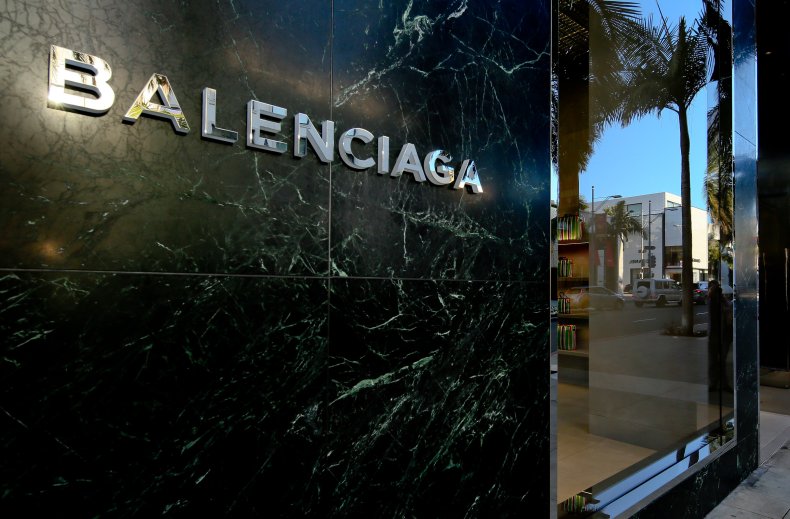What Does Balenciaga Mean in Latin?
Balenciaga’s ongoing controversy has led some conspiracy theorists to try to baselessly link the brand to satanism, based on a supposed Latin translation of its name.
The Spanish label came under fire in late November for two separate photo shoots, including one of children posing with teddy bears dressed in bondage gear.

The Balenciaga store on January 28, 2017 in Beverly Hills, California. Some conspiracy theorists have tried to link the company to the occult.
FG/Bauer-Griffi/GC Images
The other photo shoot for its campaign with Adidas featured a bag resting on sheets of paper, one of which was an excerpt from a 2008 Supreme Court ruling that upheld federal laws criminalizing the distribution, selling or advertising of child pornography.
The Supreme Court had been tasked with deciding whether laws banning “pandering”—i.e. promoting—child pornography were a violation of the First Amendment right to freedom of speech.
Along with accusations of sexualizing children, some of Balenciaga’s critics have claimed the brand is linked to Satanists and used an attempt to translate the word into Latin as proof.
One Twitter user typed in “Ba Len Ci Aga” into the Google Translate tool for a translation of that phrase from Latin into English.
The user shared the screenshot on Twitter to show the translation came out as “do what you want.” The tweet also showed how Google Translate presumed the above phrase was from Hausa—the language of the largest ethnic group in West and Central Africa of the same name.
You can’t make these things up. “Balenciaga” in Latin translates to the Satanic credo of “Do what thou wilt…” It’s all adding up. pic.twitter.com/4TRCkHMeLD
— The Benevolent Dictatorship (@SBGFL81) November 30, 2022
The tweet quickly gained traction, with many claiming it was a derivative of the “Do What Thou Wilt,” the doctrine of the early 1900s movement, Thelema.
Founded by the Englishman Aleister Crowley, Thelema’s primary rule is “Do what thou wilt shall be the whole of the law,” which is followed up by, “Love is the law, love under will.”
Others broke up the fashion company’s name this way: “Baal enci aga,” which, when put into the Google Translate tool, comes up as “Baal is king.”
Balenciaga in Latin 👇👇💥💥💥💥
Baal enci aga = Baal is the King 👹👌 pic.twitter.com/o9Ptss8SGZ
— vegastar (@vegastarr) November 30, 2022
Baal was originally used as the word for owner, master or lord in ancient Semitic languages before it came to refer to a false god, or Beelzebub in Islam and Christianity.
However, in some textbooks of magic and demonology, Baal is described as a demon king with a hoarse voice who could make men invisible.
Both translations were picked up by conspiracy theorists to prove that Balenciaga is linked to the occult.
Newsweek has reached out to Balenciaga for comment.
However, both translations are incorrect, according to Latin expert Taylor Marshall.
“As a Latin teacher, I hate to burst people’s bubble but ‘Balenciaga’ or ‘Ba Len Ci Aga’ is NOT Latin translation for the Satanic motto ‘Do what thou wilt.’ Stop spreading this misinformation,” Marshall wrote on Twitter.
The actual translation of “do what you will” in Latin is “fac sicut vis.” “Fac” is the imperative tense of the verb “to do” and the adverb “sicut” means “as” or “just as.”
In fact, the name Balenciaga has Basque origins and is the surname of its founder Cristóbal, who started the fashion label in 1919. The Basque people are the ethnic group found in north-central Spain.
Balenciaga issued an apology in late November when the scandal first came to light and on Monday, the fashion company released a longer statement.
Posted as a story on its Instagram account, it said the campaigns “reflect a series of grievous errors for which Balenciaga takes responsibility.”
“We strongly condemn child abuse; it was never our intent to include it in our narrative,” the company wrote.
“The first campaign, the gift collection campaign, featured children with plush bear bags dressed in what some have labelled BDSM-inspired outfits. Our plush bear bags and the gift collection should not have been featured with children. This was a wrong choice by Balenciaga, combined with our failure in assessing and validating images. The responsibility for this lies with Balenciaga alone.”
About the papers featured in the Adidas campaign, the company added: “were provided by third parties that confirmed in writing that these props were fake office documents.”
However, the papers “turned out to be [real] papers most likely coming from the filming of a television drama.”
“The inclusion of these unapproved documents was the result of reckless negligence for which Balenciaga has filed a complaint,” the statement read.
“We take full accountability for our lack of oversight and control of the documents in the background and we could have done things differently.”






